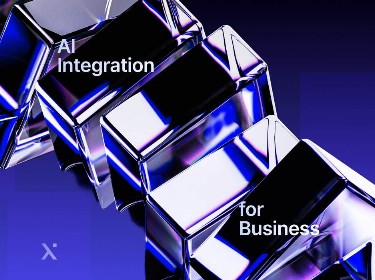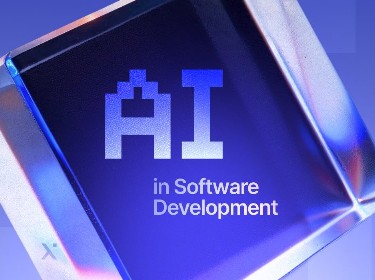Artificial intelligence has come to stay. It has become a strategic component for any organization. Banks and financial institutions are no exceptions. To remain competitive, secure, and customer-centric, they have to integrate AI for finance services and develop AI chatbots for banking.
At PixelPlex, we have been pioneering AI solutions since the technology’s emergence. Our experts are adept at leveraging its full potential to deliver best-in-class results. For this article, we’ve consolidated insights from our developers and ML engineers to create a clear roadmap, guiding you through the “why,” “how,” and “what’s next” of AI integration. Sit back, and let’s dive in.
Why use AI
![]()
Current financial trends indicate that banking institutions continue investing in AI technologies, as it proves to be a working method of increasing revenue. McKinsey reported that AI and analytics have the potential of $1 trillion annual value for global banking.
AI tools improve customer satisfaction with 24/7 assistance and personalized approaches. They offer diverse payment and lending capabilities that solve most of the challenges of traditional banking systems. As a result, customers quickly become accustomed to fast and easy services, and their expectations are rising, forcing organizations to adapt. Let’s formulate the drivers that push banks and financial institutions to search for software solutions and partners that will help them compete.
Customer experience
AI is fundamentally shifting customer expectations from reactive service to proactive, hyper-personalized engagement. The bar of personalization has reached the level where banks should anticipate customers needs before they are aware of them. Tailored services should be offered at the right time and through the right channels.
Digital ecosystems
Various sets of services are now accessible to customers through a single point. Customers want to examine, evaluate, and purchase goods in one space. For example, WeChat in China allows users to buy things, play games, send messages, apply for a loan, and perform many other activities. Therefore, financial super apps appear to offer integration into multiple financial services and challenge banks.
Operational efficiency
Internal operations of organizations that implement AI are much more effective. They are able to automate manual processes and augment human decisions due to machine learning (ML) algorithms and deep analytics. AI tools are ready to analyze large volumes of data and provide accelerated decision-making processes. Besides, generative AI integration services allow for faster adoption and testing of new features and products, and shorter time-to-market. AI for finance also helps to assess risks and detect fraudulent activities.
Here are the core drivers for the adoption of AI for banking and finance, summarized in a table:
| Driver | Description | Key benefits |
| Hyper-personalization | AI solutions for banking to analyze customer data and offer tailored products and pricing | Increased Customer Lifetime Value (CLV) |
| Intelligent process automation (IPA) | Automating complex, multi-step back-office operations | Significant cost reduction & error elimination |
| Predictive risk modeling | Leveraging ML to assess creditworthiness and predict market shifts | Lower default rates & improved portfolio health |
| Advanced fraud prevention | Real-time analysis of transaction patterns to identify and block anomalous activity | Enhanced security & customer trust |
Key applications and use cases of AI for banking and finance
![]()
Customer service
AI chatbots for banking are not only assistants that provide support to customers. Adaptive AI development services enable businesses to apply ML across the whole customer lifecycle.
- First, advanced analytics and generative AI for banking analyze and design new customer journeys. People come to banks through mobile apps, websites, through a partner domain, or by physical visit. AI tools analyze these paths and customer profiles and generate highly personalized offers and tailored landing pages.
- Second, analytics examine customers’ browsing history, social media data, cookies, site history, etc., to craft customer profiles and provisional credit scoring. This information helps segment the audience and identify the best channel for interaction.
- Third, the combination of the first two points allows for increasing customer satisfaction and targeting lookalike audiences to grow the business.
Operational and internal processes
AI for investment banking provides financial institutions with streamlined credit decisioning. For example, an AI development partner offers solutions for accelerated loan approvals. Loan management software, if powered with AI for finance and accounting, may increase the processing speed, eliminate human errors, and better adapt to increasing market demands. Besides, leading AI systems for online banking collect structured and unstructured data from conventional (credit reports, bank transactions, tax returns, etc.) and unconventional sources (utility bills, telecom usage, etc.) and generate meaningful reports to improve credit services, reduce fraud risk, or improve communication with customers.
AI Chatbots in Banking: How the Industry Grows
Custom AI Model Development
Fraud detection systems
The convenience of digital operations and interactions with banks has a drawback. It creates opportunities for cyberattacks and fraud. According to the Association of Certified Fraud Examiners (ACFE), the high cyberfraud revenues and its relatively low-risk nature (in comparison with other forms of organized crime) guarantee that cyber-scam won’t go away in the near future. Therefore, AI-powered fraud detection systems are crucial for the financial industry. For instance, computer vision for KYC checks provides the critical, verified identity data needed to later uncover complex money laundering schemes. Through pattern recognition with tools like graph neural networks, AI detects anomalous activities across financial networks. Furthermore, ML models leverage diverse data points to score risks for transactions and credit applications, identifying potentially fraudulent actors through deep network analysis.
Pixelplex has developed an advanced Web3 tool for shielding crypto wallets users against scams and fraudulent activities. The software has already blocked around 700k harmful websites. Check the details
Regulatory compliance
A combination of blockchain technology and AI for compliance in banking enables banks to benefit from smart contracts and automate payment transactions upon the delivery of goods. Furthermore, banks are constructing shared utilities that mitigate the repetitive efforts of KYC and AML checks. These efforts help financial organizations strengthen their value proposition by precise underwriting, superior security, and reduced operational overhead for document and compliance management.
The application of AI for banking by functions:
| Banking function | AI application | Specific example |
| Retail banking | Conversational AI, hyper-personalization | AI-powered mobile app that provides spending insights and savings advice |
| Commercial lending | Credit risk assessment, document analysis | ML model that analyzes bank statements & cash flow to predict default probability |
| Wealth management | Robo-advisors, sentiment analysis | Automated portfolio management based on client’s risk profile and market news |
| Operations & IT | Intelligent process automation, anomaly detection | Automating the entire customer onboarding (KYC) workflow |
| Security & fraud | Behavioral biometrics, network analysis | Detecting account takeover attempts based on unusual login behavior |
AI for banking industry benefits
![]()
Financial software development as a service provided by a reliable vendor addresses the most common challenges of the banking industry. By doing so, it provides fintech companies and neobanks with the following superiority over traditional systems:
Redesigned customer engagement
Possessing the information about the customer journey is not enough for performance improvements. It is vital to know how to interpret this information. If digital banking platforms follow the trend of, for example, Netflix, in offering convenient access to consistent content that perfectly matches viewers’ expectations, it will propel those platforms to top positions.
Conversational AI for banking is another option to boost customer satisfaction. Erica, the virtual assistant of Bank of America, has assisted around 50 million users since its launch in 2018. 98% of users report that Erica has helped them to find relevant information, which relieves the workload of the call center specialists.
Cost savings
Digital transformation provides banks with opportunities to serve more customers, increase market share, and reduce operational costs. Solutions with AI for finance tools automate paperwork, customer services, and decision making. Deloitte predicts that by 2028, the banking industry will save from 20% to 40% in software investments due to AI.
Risk mitigation
The algorithms of AI for finance may screen prospective customers with greater accuracy than human experts by analyzing a wider array of data metrics. As a result, the software detects high risk of default or fraud faster, quantifying the savings.
Here are some examples of common metrics from various spheres of financial business that might be improved with the implementation of generative AI for banking:
| Area of impact | Key metric | Potential improvement with AI |
| Customer service | Average Handling Time (AHT) | Reduction of 30-50% with chatbots handling Tier-1 support |
| Loan processing | Cycle time | Reduction from days to hours or minutes |
| Fraud management | False positive rate | Reduction of up to 50-60%, freeing investigators’ time |
| Marketing | Campaign conversion rate | Increase of 10-25% through hyper-personalization |
Fraud Detection Using Machine Learning
Machine Learning in FinTech Use Cases
The roadmap to integration: A phased process
According to Gartner, the enterprise IT expenses on software among banking and investment services are going to increase by 8.4% and reach $793.5 billion in 2025. Deloitte mentions (with reference to Citigroup) that some banks employ from 15% to 25% of their staff in software related departments. However, in spite of such substantial investments, there is still space for improvements.
According to the same report from Deloitte, very often, banks’ software systems are inefficient and fail to scale. It causes high maintenance costs, integration problems, and slow performance. Top AI agents for finance are able to address those issues. Generative AI for banking models can be trained to rewrite obsolete code and assist developers in modernizing legacy systems. Applying AI and custom AI chatbot development services to help internal banks’ IT departments transform their software is a promising trend. Studies made in this field prove the idea that AI models will get even more mature and provide experts with possibilities to write faster and more efficient programs.
Here are the steps that CIOs and software engineering leaders of financial organizations and banks have to take when they decide to integrate AI into their processes:
- Determine the areas with serious and ongoing inefficiencies. They will be the first priority spots for the initial use of AI tools.
- Talk openly with technical teams about how their jobs might change. Tell them about the available training to learn new skills and the new positions that AI will create. To reduce worry and build support, keep everyone informed with news, hold honest Q&A sessions, and outline clear career growth options.
- Create strong rules and oversight for managing AI projects. Leadership needs to set up a system with defined guidelines that tackles possible problems like misuse of private data, biased computer decisions, and workflow breakdowns.
- Address external technology partners that can recommend the best AI tools for enhancing digital banking or develop such tools from scratch. This is often crucial for banks that don’t have the massive resources or specialized systems to create their own AI solutions.
- Communicate your strategy and updates to both internal and external parties. Explain how you are adding AI into your software work and what safety steps you are taking to control the risks.
- Finally, form integrated groups with members from different departments to manage the AI rollout. This helps ensure leaders from all parts of the business work together effectively.
How to Apply Machine Learning in Banking
Machine Learning in Anti-Money Laundering
Navigating the challenges
![]()
Current demands force traditional systems to apply generative AI for banking services. This technology claims to provide banks with the agility and speed of fintech firms. And this is difficult to argue with. At the same time, being financial services enterprises, banks have to support the reputation of a reliable organization that manages the security standards and complies with regulatory requirements. Trying to achieve both is a challenging task. Here are the problems that banks might face while integrating new technologies.
- Data quality: The effectiveness of AI models depends first and foremost on the quality of their training data. If the input data is biased, repetitive, or contains errors, the output will be flawed. At the same time, organizations have to remember about data privacy and not disclose sensitive information to AI models. Fortunately, careful data cleaning and the use of synthetic data can help mitigate these issues.
- High implementation costs: Integrating new technologies involves multiple steps and demands significant investment in software, infrastructure, and expertise. However, in the long run, banks will receive high ROI through automated workflows and reduced operational costs.
- Talent gap and skill shortage: Finding competent data scientists and ML engineers might become a complex task. However, partnering with a reliable AI app development company frees businesses from the necessity to hunt for top experts internally, providing immediate access to specialized skills.
- The “black box” problem: In many complex AI models, even their creators cannot easily explain why a specific decision was reached. It is a problem for regulators and auditors who require clear justification for decisions, especially in sensitive areas like loan approvals. To solve the “black box” problem, banks must prioritize the development and implementation of explainable AI (XAI) techniques that provide clear, auditable insights into how their models make critical decisions.
- Integration with legacy systems: Recommended AI solutions for digital banking require robust technology infrastructure. Legacy systems might lack the capacity and flexibility needed for data-processing or real-time analysis. A competent tech partner can identify the areas that need immediate transformation and solve integration problems iteratively.
- Cultural resistance: Employees may fear that AI will make their roles obsolete or drastically change their workflows, leading to skepticism and resistance. To overcome this, banks must foster a culture of continuous learning, clearly communicating that AI is a tool to augment human capabilities, not replace them.
Here is a list of the most common AI integration challenges and mitigation strategies:
| Challenge | Potential impact | Mitigation strategy |
| Poor data quality | Inaccurate models, flawed insights | Invest in data cleansing and a centralized data lake |
| Legacy system integration | High implementation cost & time | Use API-first AI solutions and a phased modernization approach |
| Lack of in-house expertise | Project delays, failed deployments | Partner with expert vendors (like PixelPlex) and invest in upskilling |
| Regulatory & ethical concerns | Fines, reputational damage | Prioritize explainable AI (XAI) and implement a robust AI governance framework |
Learn how PixelPlex created a decentralized ecosystem that puts users in charge, offering key DeFi services like lending, staking, and governance within a transparent, community-led platform. Examine the case
How much does AI integration cost?
Costs are variable and depend on a bunch of conditions. The components of the final cheque are the type of software, licensing terms, third-party services, language models preparation and training, team of experts, their competence and location, post-launch maintenance, and other factors.
Look through the general information about the AI implementation cost breakdown, including some of the cost components:
| Cost component | Low-complexity project | High-complexity project | Notes |
| AI software/SaaS license | $50k – $100k / year | $200k+ / year | Depends on transaction volume and features |
| Implementation services | $100k – $250k | $500k – $1M+ | The core cost for system integration and customization |
| Data engineering | $50k – $100k | $150k – $300k | Highly dependent on the state of existing data |
| Internal resource allocation | 1-2 FTEs | 5-10+ FTEs | Project managers, subject matter experts, etc. |
How Much Does AI Development Cost
How to Implement AI-Based Recommendation System
The geographical location of the development team impacts the final cost of AI services. Teams in North America and Western Europe represent the premium tier, commanding the highest rates due to their high cost of living and expertise levels. In contrast, regions like Eastern Europe and Latin America offer a compelling balance of high-quality engineering talent and competitive rates, which provide significant value. Meanwhile, teams in parts of Asia often present the most cost-effective option, though factors like language barriers and time zone differences might introduce additional project management complexity.
Best-in-class AI solutions for banks
![]()
JPMorgan Chase: IndexGPT
In 2023, JPMorgan Chase announced an AI for finance product called IndexGPT. The name resembles the conversational AI ChatGPT, and it is not without reason. It’s a financial assistant with generative AI for banking algorithms that helps customers select securities for their investment baskets. It analyzes a vast array of text sources (news, social media, financial reports, etc.) to identify market trends and create thematic investment portfolios for customers.
Why it’s best-in-class: Customers received a tool to ease the complex process of portfolio construction. Besides, JPMorgan became the first major bank to commercialize AI. They sold IndexGPT as a product, creating a new revenue stream.
Capital One: Eno
Eno is the next virtual assistant on the list of the most effective AI chatbots for banking. Capital One developed the program in 2017. It exchanges messages with customers, helping them with things like fraud alerts, subscription monitoring, and complex account questions. Eno is capable of NLP and recognizes emojis.
Why it’s best-in-class: Eno has gone beyond common chatbot features. It’s a context-aware AI that provides genuine value, making it a gold standard for customer-facing AI in retail banking. By providing unique, money-saving features, Eno fosters deeper customer relationships and brand loyalty.
Goldman Sachs: Marcus insights & AI in investment banking
Marcus is an online platform that uses AI to provide financial services to clients. For example, it offers personal financial management (PFM) and automated loan underwriting.
Simultaneously, the firm’s investment banking and trading divisions leverage AI for far more complex tasks. This includes developing sophisticated trading algorithms and conducting deep analysis for mergers and acquisitions. For wealth management clients, these advanced systems can monitor a portfolio to detect overexposure to a specific sector. When market volatility or regulatory changes create risk, the AI recommends strategic diversification, enabling clients to proactively safeguard their assets.
Why it’s best-in-class: It demonstrates the application of AI at the highest levels of finance, from consumer lending to multi-billion dollar corporate deals. The tool facilitates investment decisions, therefore, retaining customers.
DBS Bank: DBS IDEAL™ RAPiD
RAPiD is an AI-powered feature within DBS’s online banking platform for businesses. It uses predictive analytics and optical character recognition to automate and streamline trade finance transactions. The system can pre-fill complex forms, predict the next steps in a transaction, and flag discrepancies in documents.
Why it’s best-in-class: The tool reduces the time to complete a trade finance transaction from 2 days to under 2 hours. It’s a prime example of B2B banking AI, moving from simple automation to predictive and prescriptive analytics for corporate clients.
Morgan Stanley: AI Morgan Stanley Assistant
An AI Morgan Stanley Assistant appeared in 2023. It is based on OpenAI’s ChatGPT technology. An Assistant is a virtual “copilot” for the staff that helps them to find the answers to questions related to investment, internal processes, business performance, and others. It reduces the research time and allows for better efficiency. Besides, it helps ensure that advice given across the organization is based on the firm’s latest, vetted research and complies with internal guidelines.
Why it’s best-in-class: First of all, it is a landmark example of a strategic partnership between Wall Street and a leading AI lab. Secondly, it makes the bank’s proprietary research instantly accessible to all advisors.
Citigroup: Citi Data Insights
Citibank uses big data analytics to examine and generate insights from large volumes of data. It also uses ML algorithms to offer its customers new features. A suite of AI functionalities provides clients with unique, data-driven insights into trade flows, treasury management, and market dynamics.
Why it’s best-in-class: It transforms Citi from a pure transaction processor into a strategic partner that provides intelligent insights. It helps corporate treasurers better understand their financial position, predict future cash needs, and identify inefficiencies in their supply chains.
AI and Privacy: Key Business Concerns and Solutions
Exploring Key Generative AI Applications and Use Cases Across Industries
Top companies aiding AI integration in banking
![]()
We have compiled a list of the best AI for finance providers based on their fintech expertise, depth of AI capabilities, strength of platform integration, and proven client success in the domain.
- PixelPlex
PixelPlex has more than thirteen years of experience in software development and blockchain. With the appearance of AI, we have proactively integrated it into our practice, enhancing the solution stack. This allows us to serve as a trusted technology partner for organizations of all sizes across various industries, including the demanding financial sector. We have successfully delivered numerous specialized blockchain initiatives as part of our 450+ total projects. Our mission is to deliver intelligent, scalable, and secure software that solves complex business problems by leveraging the combination of blockchain’s security and AI’s predictive intelligence. - IBM
IBM is known as a titan in enterprise technology. Its Watson AI platform, combined with a strong hybrid cloud capability, serves large, global financial institutions that cannot fully migrate to the public cloud due to security or data sovereignty concerns. IBM excels in areas requiring deep NLP and robust governance, making its solutions for regulatory compliance, AML, and risk analysis particularly powerful. - SAS
SAS has a decades-long reputation specifically within financial services. It boasts incredibly mature and specialized solutions for fraud detection and risk management. Its models use vast historical datasets, which result in unparalleled accuracy in identifying complex financial crimes and assessing credit risk. Banks often engage SAS to achieve best-in-class outcomes, sometimes as a complementary system that strengthens a broader AI ecosystem managed by another platform partner. - Google Cloud
Google Cloud offers banks its Vertex AI platform, which is built on the same infrastructure that powers Google’s own services. The platform offers cutting-edge ML tools and scalability. In combination with BigQuery, a powerful data analytics engine, it generates valuable insights from banks’ data and builds highly sophisticated predictive models for customer engagement, personalized marketing, and algorithmic trading. - Microsoft Azure AI
Microsoft’s strategy is to democratize AI by embedding it directly into the tools that experts use daily. Azure AI integrates with Office 365, Dynamics, and the Power Platform. This allows banks to quickly infuse AI, such as document intelligence, cognitive services, and chatbot capabilities, into existing workflows with high developer familiarity and lower friction. For financial institutions standardized on the Microsoft stack, Azure AI offers a practical, efficient, and highly integrated path to enhancing productivity and customer experience across the organization. - NICE
NICE focuses on the front office, specializing in transforming customer engagement and contact center operations. Its AI-driven platform offers conversational AI, process automation, and voice and text analytics. By analyzing 100% of customer interactions, NICE provides deep insights into customer sentiment, agent performance, and compliance issues, while also powering intelligent virtual assistants. For banks where elevating the customer service experience and optimizing the massive contact center function are top priorities, NICE delivers targeted, high-impact solutions that directly affect customer satisfaction and operational efficiency.
| Company | Core specialization & focus | Key strengths | Ideal for |
| PixelPlex | Deep expertise in blockchain and AI | Experience, team, and a proven track record of 450+ delivered projects | Organizations of all sizes that seek a trusted technology partner to build blockchain and AI solutions |
| IBM | Watson AI Platform Hybrid Cloud | Powerful NLP and robust solutions for risk and compliance | Large financial institutions with complex on-premise or hybrid cloud environments and a focus on governance |
| SAS | Advanced analytics, fraud & AML, risk management | Mature and proven solutions for fraud detection and credit risk | Banks that need specialized solutions for risk and analytics, often in a complementary role to a broader platform |
| Google Cloud | Vertex AI Platform, big data & analytics, AI infrastructure | Data analytics and AI/ML tooling (BigQuery, TensorFlow); AI for customer engagement and predictive modeling | Banks with a strong data science culture and a focus on innovation and scalability |
| Microsoft Azure AI | Cloud AI services, integration with Microsoft ecosystem | Integration with Microsoft stack (Office, Dynamics); strong suite of pre-built and customizable cognitive services | Banks that are standardized on the Microsoft ecosystem and want to infuse AI into existing workflows |
| NICE | Conversational AI, process automation, CX analytics | Customer engagement and front-office automation with AI-driven voice and text analytics | Banks looking for a transformation of the contact center and customer service |
Experts at PixelPlex believe that the future of AI in banking will be connected with even deeper integration and new capabilities. “AI-first banks”will emerge. These are institutions built completely with AI at their core, not just as an add-on. Generative AI will become commonplace, creating hyper-personalized marketing, powering conversational banking, and helping developers write code faster. As regulators demand more clarity,explainable AI(XAI) will become a standard requirement to ensure models are transparent and their decisions are justifiable. Finally, AI will play a crucial role in ESG(environmental, social, and governance), helping institutions assess climate-related financial risks and identify promising sustainable investment opportunities.
Conclusion
Summing up what was mentioned, the adoption of AI technologies is a strategic necessity for banks and financial institutions. AI provides businesses with better performance results and makes them competitive. Financial leaders have to start their AI journeys with a clear strategy, a focus on data, and by choosing the right partners to navigate this complex but rewarding landscape. PixelPlex is there to help, apply our knowledge and best practices to ensure your business receives the results you’re striving for.
FAQ
There are different types of AI suitable for various business needs. Whether you are looking for AI for investment banking, retail banking, or commercial lending, you should compare the tools, their functionality, pricing models, and scalability. Sometimes it is better to develop a solution from scratch to make it fully match your expectations.
At PixelPlex, our process is built on a foundation of thorough quality assurance, a principle central to our approach as a manual testing company. We always start with a discovery phase to understand our clients’ goals and assess their existing systems. We then design a strategic blueprint for the architecture, user experience, and integrations. Next, we prepare and clean the training data for the machine learning models, followed by iterative development and testing. After deployment, we provide ongoing maintenance and support to ensure optimal performance.
While ChatGPT can handle general tasks like explaining tax concepts or drafting simple customer communications, it is not a suitable foundation for a banking system. It lacks access to your proprietary data and the computational power for critical functions like risk analysis or audit testing. Relying on it for financial decisions poses significant reputational and compliance risks.
This is highly unlikely. AI serves as a powerful assistant that accelerates research and data analysis. However, the final decision, which requires understanding nuanced personal circumstances and building trust, remains firmly in the hands of the human expert.
It is the data that is artificially generated. Synthetic data mimics real customer data’s patterns and statistics without containing any actual personal details. It allows banks to train and test AI models safely, avoiding privacy risks and data breaches.
ROI comes from massive operational automation (cutting costs), superior fraud detection (reducing losses), and hyper-personalization (increasing revenue). Most implementations pay for themselves and generate significant value.




